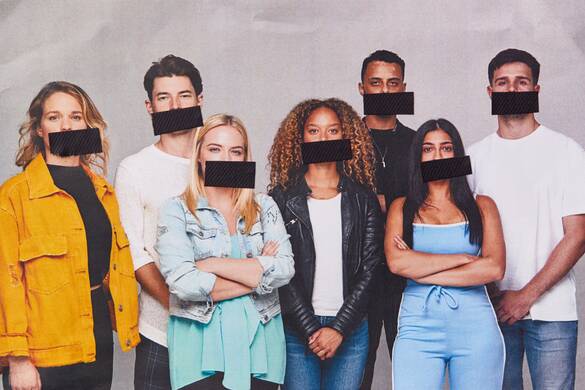A Dorian Gray effect
In eight studies, we show that participants exposed to portraits (ID picture type) of people they never met before, are able to recognize the first name of the depicted person well above chance level. Consider, for example, that you live in North-America, and that you see the picture of an Emily. Below her picture, four possible first names are presented: Claire, Deborah, Emily and Melissa. Not knowing Emily, and assuming that the other first names were given to a similar extent in North-America in/around the year that Emily was born, participants should pick Emily (or any of the other names) around 25% of the time (i.e., by chance). What we find is that participants typically choose the depicted person’s true first name 35% to 40% of the time. In other words, there is something about Emily that looks like… « an Emily ».
Obviously, if Emily looks like an Emily, even a computer should be able to recognize her true name. After having shown a few dozens Emilys and non-Emilys to a computer, we submitted the analysis of almost 100000 pictures to the computer. Across the board, the computer was able to recognize the true person’s first name above chance. In fact, the computer is even able to produce a “heat map”, or a face of Emily showing in warm colors the areas of her face that “betray” her as an Emily. In our computer study, we produced heat maps for a variety of French names (see picture on top of this article).
How should we understand this effect? Until now, social psychologists knew that our facial appearance influence the extent to which others perceive us as attractive, intelligent, trustworthy or warm. This study shows that the reverse also holds: others’ perception of our first name shows up in our face.
How is that possible? We suggest that when a child receives a first name, the latter comes charged with a number of social expectations, inferences and interactions. It is possible that this child be treated as though s/he has certain personality traits (e.g., a Katherine may be a good student; an Allison may be mischievous). The social attitude toward a first name, along with its continuous pressure on the person wearing that name can influence the perception that the name-wearer has of themselves, and end up weighing on the development of their facial appearance. To illustrate, Allison may end up adopting a hairdo, expressions or specific facial traits (e.g., smile lines) consistent with the stereotype of an Allison that her cultural group has in mind.
Self-fulfilling prophecy is already well-documented as far as personality is concerned (e.g., a stereotype of Chinese being that they are good at maths, a Chinese woman being reminded of the fact she is Chinese tends to perceive herself as better at maths compared to a Chinese woman being reminded of the fact that she is a woman). What is new with our research is to show that our motivation to tend toward social stereotypes ends up showing on our face, at least via the social cue that our first name constitutes.
This may happen either directly (e.g., Allison wears her hair long; Angelina ties it up) or go via the effect of a first name on people’s personality (e.g., a first name may be associated with someone who is open-minded, which would then translate on a more open-looking face). We therefore identify a type of Dorian Gray effect, from the lead protagonist in Oscar Wilde’s novel, whose portrait evolves as he carries out evil acts. The fact that our first name, chosen by others than us, deeply shapes our appearance in adulthood, suggests a powerful social structuring effect impacting us from our early on in our life.
Our motivation to tend toward social stereotypes ends up showing on our face, at least via the social cue that our first name constitutes.
A social structuring cue adapted to our reference group
The face-name effect — the fact that we recognize the first name of someone we don’t know beyond chance level— knows boundaries, which illustrate all the more the suspected self-fulfilling mechanism behind it. First of all, we find that individuals of a given culture display the face-name effect when looking at pictures of individuals from their culture, but no longer recognize the name when the pictures are of individuals from another culture.
In one of our studies, we asked in parallel French and Israeli participants to recognize the true name of French and Israeli people they did not know. The face-name effect occurred for French people confronted to French faces, as well as for Israelis confronted to Israeli faces. It did not occur for French people confronted to Israeli faces, as well as for Israelis confronted to French faces; in other words, the recognition of the depicted people’s true name was not more frequent than chance level.
In another study, we show that, if the people depicted do not use their first name socially, but an exclusive nickname instead (e.g., Charlotte does not go by Charlotte, but by « Chachou »), the face-name effect disappears, and people no longer recognize Charlotte as a Charlotte. Again, this is consistent with the fact that the name-wearer undergoes a social pressure when s/he morphs their face to tend toward the stereotype of their first name. When using an exclusive nickname, for which there is no shared stereotype, this pressure disappears.
Finally, a study shows that the face-name effect occurs even if we can only see the hairdo of a person. Our hair is possibly the part of our face that we control with the most ease. The fact that they alone can produce the face-name effect further illustrates the self-fulfilling prophetic mechanism suspected behind it.
Together, our studies suggest that we wear our social belonging on our face, and that we actively shape our features to be recognized by our reference group. Choosing our baby’s first name remains exciting and anxiety-eliciting. Whichever the first name you give to your child, it will act as a seal on your child’s face.








